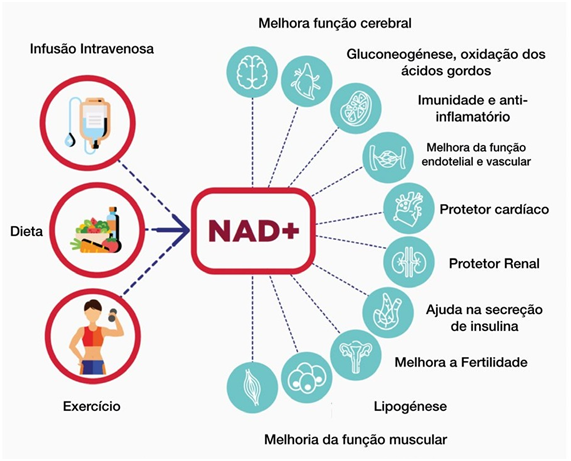NAD+ is a substrate for a number of important enzymes, including poly (ADP-ribose), polymerase (PARP) and sirtuin 1 (SIRT1), known as a longevity protein. NAD+ is also essential in metabolic processes such as the creation of ATP in mitochondria (cellular organelles responsible for producing energy), which is very important in post-surgical recovery. NAD+ accepts and donates electrons, in addition to being used in oxidation reduction reactions in the electron transport chain at the mitochondrial level.
NAD+ , endocrinology and metabolism
Scientists have observed that NAD+ levels decrease in most tissues over time, being associated with ageing in general, therefore, it plays an important role in many age-related diseases.
According to an article in Endocrinology and Metabolism, researchers have demonstrated that when NAD+ recovery pathways in the muscle are impaired, mitochondrial dysfunction and a decrease in muscle mass occurs.
NAD+ booster molecules such as nicotinamide riboside (NR), nicotinamide mononucleotide (NMN), niacinamide (a form of vitamin B3 or niacin) and nicotinic acid (niacin) have been shown to be effective in fighting age-related muscle diseases.
Niacin, also known as “vitamin B3” or “vitamin PP”, encompasses two vitamins (nicotinic acid and nicotinamide) at the origin of coenzymes: nicotinamide adenine dinucleotide (NAD+) and nicotinamide adenine dinucleotide phosphate (NADP+). The two coenzymes (oxidized and reduced forms) are crucial for redox balance and energy production, but they are also substrates for enzymes involved in non-redox signaling pathways, thus regulating biological functions including gene expression, cell cycle progression, DNA repair and cell death.
- Niacin sources can be exogenous (diet or therapeutic supplementation) or endogenous (biosynthesis from a precursor).
- Depending on whether or not its contribution can meet the metabolic requirements, situations of deficiency in the human body can be generated, with more or less clinical severity.
- There seems to be a predominance of nicotinic acid in plants, while in animals nicotinamide predominates.
- The metabolic pathways of niacin and its derivatives are complex and are not yet fully elucidated.
Their pharmacological properties are relevant and numerous, from the prevention of pellagra (vitamin B3 deficiency) to cancer. NAD+ levels decrease with age, resulting in an imbalance in the body’s homeostasis, leading to increased susceptibility to disease. This fact leads to the idea that the restoration of NAD+ levels could prolong the years of a healthy life. The most obvious way to increase NAD+ is to supplement its precursors. There are important scientific works that demonstrate and evidence how niacin is indispensable for human health.
Niacin acts as an anti-pellagra, lipid-lowering, neuroprotective, anti-ageing, anti-inflammatory, pleiotropic agent in the progression of chronic kidney disease, in the regression of steatosis and is important in the treatment of cancer. We increasingly believe that supplementation with this vitamin is critical in some patients, when there are concomitant systemic health problems that may affect healing after oral surgery.
As shown by Science Daily, scientists recently suggested that Alzheimer-like protein aggregates are behind the muscle deterioration seen in ageing, and that nicotinamide adenine dinucleotide (NAD+) is crucial in combating this condition.
The study, published in the journal Cell Reports, showed that protein aggregates (amyloid) can be blocked by raising levels of NAD+, a biomolecule that is also essential for maintaining mitochondrial function.
Higher levels of NAD+ have been found to activate mitochondrial defense systems and restore muscle function. It was long believed that aggregated proteins only contributed to brain ageing, but this study shows that they also contribute to muscle ageing.
The study points out that NAD+ homeostasis is necessary to maintain proteostasis, that is, the regulation of protein creation, folding, circulation and degradation. Increasing NAD+ later in life will reduce amyloidosis (the accumulation of amyloid) and mitochondrial dysfunction.
According to a study done by Cell Report, this Endocrinology and Metabolism article highlights the link between sarcopenia and mitochondrial dysfunction, both in skeletal muscle and motor neurons.
It has been suggested that people with sarcopenia have reduced mitochondrial oxidative capacity and inhibited NAD+ biosynthesis. Several studies have proposed that mitochondrial dysfunction leads to the development of sarcopenia.

How can NAD+ supplementation help us in dentistry?
NAD+ therapy replenishes decreasing levels of nicotinamide adenine dinucleotide (NAD), which contributes to healthy cell function and immune response. NAD therapy also improves metabolism, energy levels and overall health, which in turn helps reduce systemic inflammation.
In dentistry cases where the patient has chronic inflammation, such as periodontal disease, or infections in the jaw (NICO – Neuralgia-inducing Cavitational Osteonecrosis), these supplements with NAD+ are recommended because given that they fight inflammation and infectious processes, they also strengthen the immune system. As is known, our team has a lot of experience in the application of LLLT, or Low Level Light Therapy or photobiomodulation which, depending on the technology used, will have an immediate effect on the production of ATP energy through specific light waves. As such, the combination of supplements that might contribute to this action mechanism is something worth studying.
At White Clinic, we follow a supplementation protocol that not only helps with healing and bone regeneration, but is also capable of strengthening the immunity of our patients, in order to fight infections more naturally, while contributing to healthy longevity. NAD+ is part of our protocol, along with other supplements such as complex B vitamins, vitamin C, magnesium, vitamin D, and vitamin K2, among others.




